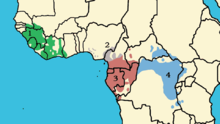Common chimpanzee
| Common chimpanzee Temporal range: 4–0 Ma |
|
|---|---|
 |
|
| Scientific classification | |
| Kingdom: | Animalia |
| Phylum: | Chordata |
| Clade: | Synapsida |
| Class: | Mammalia |
| Order: | Primates |
| Suborder: | Haplorhini |
| Family: | Hominidae |
| Subtribe: | Panina |
| Genus: | Pan |
| Species: | P. troglodytes |
| Binomial name | |
|
Pan troglodytes (Blumenbach, 1776) |
|
 |
|
| distribution of common chimpanzee. 1. Pan troglodytes verus. 2. P. t. ellioti. 3. P. t. troglodytes. 4. P. t. schweinfurthii. | |
| Synonyms | |
|
Simia troglodytes Blumenbach, 1776 |
|
| NCBI genome ID | 202 |
|---|---|
| Ploidy | diploid |
| Genome size | 3,323.27 Mb |
| Number of chromosomes | 24 pairs |
Simia troglodytes Blumenbach, 1776
Troglodytes troglodytes (Blumenbach, 1776)
Troglodytes niger E. Geoffroy, 1812
Pan niger (E. Geoffroy, 1812) Anthropopithecus troglodytes (Sutton, 1883)
The common chimpanzee (Pan troglodytes), also known as the robust chimpanzee, is a species of great ape. Colloquially, the common chimpanzee is often called the chimpanzee (or "chimp"), though this term can be used to refer to both species in the genus Pan: the common chimpanzee and the closely related bonobo, formerly called the pygmy chimpanzee. Evidence from fossils and DNA sequencing shows both species of chimpanzees are the sister group to the modern human lineage.
The common chimpanzee is covered in coarse black hair, but has a bare face, fingers, toes, palms of the hands, and soles of the feet. It is considered more robust than the bonobo, weighing between 40 and 65 kg (88 and 143 lb) and measuring about 63 to 94 cm (25 to 37 in). Its gestation period is eight months. The infant is weaned at about three years old, but usually maintains a close relationship with its mother for several more years; it reaches puberty at the age of eight to 10, and its lifespan in captivity is about 50 years.
The common chimpanzee lives in groups which range in size from 15 to 150 members, although individuals travel and forage in much smaller groups during the day. The species lives in a male-dominated, strict hierarchy, which means disputes can generally be settled without the need for violence. Nearly all chimpanzee populations have been recorded using tools, modifying sticks, rocks, grass, and leaves and using them for acquiring honey, termites, ants, nuts, and water. The species has also been found creating sharpened sticks to spear Senegal bushbabies out of small holes in trees.
...
Wikipedia

